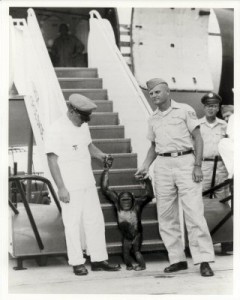Astrochimp’s 1961 Bermuda Splashdown
 Chimpanzees are the forgotten link in America’s manned space programme — with the first, simian-piloted US space capsule to orbit the earth splashing down off Bermuda 50 years ago today [Nov. 29].
Chimpanzees are the forgotten link in America’s manned space programme — with the first, simian-piloted US space capsule to orbit the earth splashing down off Bermuda 50 years ago today [Nov. 29].
When the space programme was in its infancy in the early 1960s, the US National Aeronautics & Space Administration used chimps to test how space flight would affect the human body.
Before astronaut Alan Shepard Jr. made his famed first American suborbital space flight in 1961, a chimpanzee named Ham completed a successful suborbital flight in a Mercury capsule.
“There were a lot of unknowns back in the ’50s about how the human body would react to space and some real bad concerns that you might die,” former NASA space shuttle astronaut Robert Crippen has said. “And these [chimps] opened that up to at least give people confidence that it was OK to go put Al Shepard and the guys up for the first time.”
And in a dress rehearsal for John Glenn’s historic 1962 orbital flight, chimpanzee Enos blasted into space in Florida on board a NASA Mercury Atlas 5 on November 29, 1961.
The young chimpanzee completed his first orbit in one hour and 28.5 minutes.
Enos was originally scheduled to complete three orbits, but was brought back after the second orbit because the spacecraft was not maintaining proper attitude.
According to observers, Enos jumped for joy and ran around the deck of the recovery ship USS “Stormes” which retrieved his capsule off Bermuda, enthusiastically shaking the hands of his rescuers.
Flight Of Astrochimp Enos And His Arrival In Bermuda After Splashdown
Aboard the “Stormes”, he ate two oranges and two apples, his first fresh food since he had gone on a low-residue pellet diet.
The destroyer dropped Enos at the Kindley US Air Force Base hospital in Bermuda. The chimp was walked in the hospital’s corridors and appeared to be in good shape. His body temperature was 97.6 degrees; his respiratory rate was 16; and his pulse was 100. Apparently reentry, reaching a peak of 7.8 g, had not hurt him.
His quiet composure at his Bermuda “press conference” surprised the correspondents.
On December 1, 1961 Enos left Bermuda for Cape Canaveral in Florida for another round of physicals [pictured at top]. A week later he departed for his home station at Holloman Air Force Base in New Mexico for well-deserved retirement.
Enios’ was the second and last chimp mission into space, the flights having proved humans could withstand the rigorous conditions of blast off, weightlessness and re-entry. On November 4, 1962, Enos died of dysentery caused by shigellosis, which was resistant to antibiotics of the time.
The chimpanzee had been under constant observation for two months before his death. Pathologists reported that they found no symptom that could be attributed or related to his space flight a year before.
Dr. Marvin Grunzke, a US Air Force major and aeromedical specialist, was a key trainer in NASA’s “animals in space” programme. In the interview below he talks here about the 50-year anniversaries of the two astrochimp space flights.


Comments (2)
Trackback URL | Comments RSS Feed
Articles that link to this one: